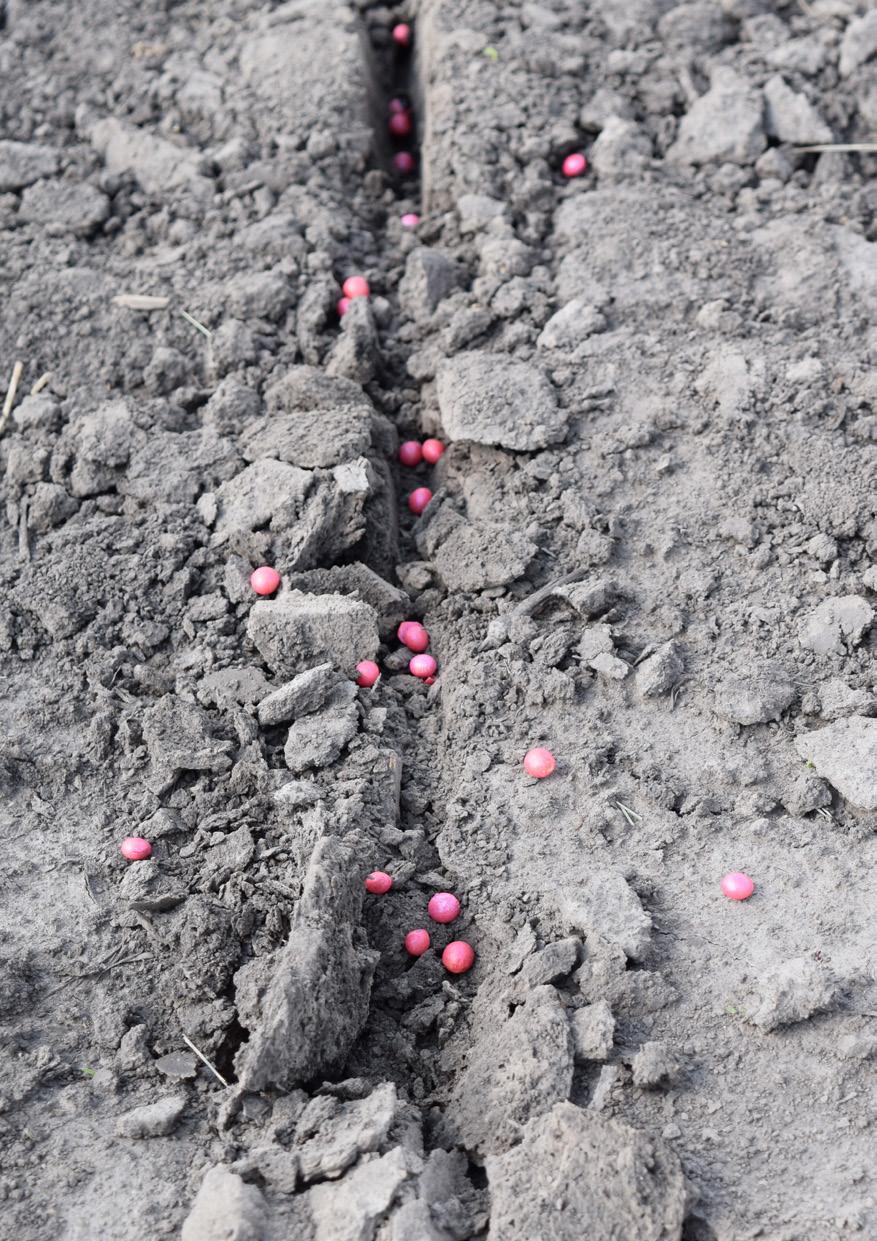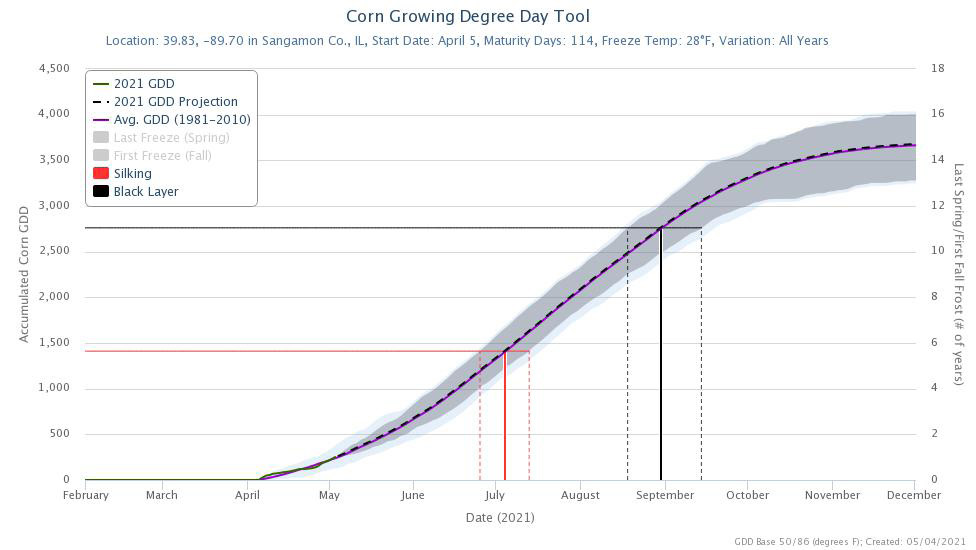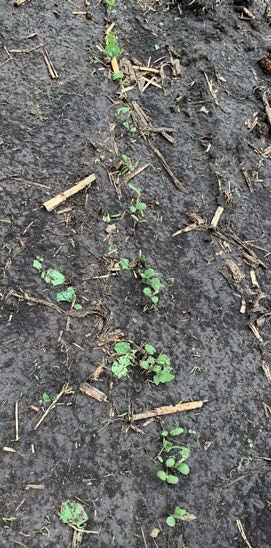Retail Agronomy Update
May 10, 2021
Corn and Soybean Re-Plant Tips
U of I put tables together illustrating plant populations, planting date, and % expected yield that can come in handy when it comes to making replanting decisions. Obviously, there are many other factors to consider such as commodity and input prices, time and labor, and overall plant health, and most importantly, YIELD when it comes to replant decisions. We observed a field last week that was planted on April 5 and soybean stands were reduced to 75,000 plants with some 3 ft gaps. If we look at Table 2, we can see that we could expect 94% yield from these reduced stands and about 2% yield loss from gaps (see Agronomy Bulletin). However, replanting soybeans (let’s say May 11-18 at the earliest) AND getting an ideal stand of 120,000 plants/acre, would result in soybean yields of 92% of maximum expected. Replanting may not be recommended in this case, especially if replant is delayed even further.
Also, reference the Corn & Soybean Replant Decisions Agronomy Bulletin from BRANDT for more info.
Table 1. Corn Yields (Percent of Maximum) for Different Combinations of Planting Date and Plan Population. Derived from the Results of 39 Planting Date and 44 Plant Population Trials in Illinois
| Planting Date | Plant Stand, 000/acre | ||||||
|---|---|---|---|---|---|---|---|
| 20 | 23 | 26 | 29 | 32 | 35 | 38 | |
| expected yield, % of maximum | |||||||
| Apr 1-10 | 84 | 88 | 91 | 94 | 97 | 98 | 99 |
| Apr 11-20 | 84 | 89 | 92 | 95 | 97 | 99 | 100 |
| Apr 21-30 | 84 | 88 | 92 | 95 | 97 | 99 | 99 |
| May 1-10 | 83 | 87 | 90 | 93 | 95 | 97 | 98 |
| May 11-15 | 81 | 85 | 89 | 91 | 93 | 95 | 96 |
| May 16-20 | 79 | 83 | 87 | 90 | 92 | 93 | 94 |
| May 21-25 | 78 | 82 | 85 | 88 | 90 | 91 | 92 |
| May 26-31 | 75 | 79 | 82 | 85 | 87 | 88 | 89 |
| June 1-5 | 73 | 76 | 79 | 82 | 84 | 85 | 86 |
Table 2. Soybean Yields (Percent of Maximum) for Different Combinations of Planting Date and Plan Population. Derived from the Results of 29 Planting Date and 25 Plant Population Trials in Illinois
| Planting Date | Plant stand, 000/acre | ||||||||||
|---|---|---|---|---|---|---|---|---|---|---|---|
| 50 | 60 | 70 | 80 | 90 | 100 | 110 | 120 | 130 | 140 | 150 | |
| expected yield, % of maximum | |||||||||||
| Apr 10-20 | 89 | 91 | 93 | 95 | 96 | 97 | 98 | 98 | 99 | 99 | 99 |
| Apr 21-30 | 88 | 90 | 92 | 93 | 94 | 95 | 96 | 97 | 97 | 98 | 98 |
| May 1-10 | 86 | 88 | 90 | 91 | 92 | 93 | 94 | 95 | 95 | 95 | 96 |
| May 11-18 | 83 | 85 | 87 | 89 | 90 | 91 | 91 | 92 | 92 | 93 | 93 |
| May 19-26 | 81 | 83 | 84 | 86 | 87 | 88 | 88 | 89 | 89 | 90 | 90 |
| May 27 - Jun 3 | 78 | 80 | 81 | 82 | 84 | 84 | 85 | 86 | 86 | 86 | 86 |
| June 4-11 | 74 | 76 | 77 | 79 | 80 | 81 | 81 | 82 | 82 | 82 | 83 |
| June 12-19 | 70 | 72 | 73 | 74 | 75 | 76 | 77 | 78 | 78 | 78 | 78 |

Growing Degree Unit Accumulations & Black Cutworm

As we all know GDU’s can be tied to so many factors such as corn growth stage and insect development. With a start date of April 5, GDU progression is on track with 30 year average. With a 114 day corn hybrid planted April 5, V6 is expected May 28, silking is expected July 4, and black layer on August 29.
Insect emergence/feeding is also related to degree days/units; however, insects have their own specific base temps and start dates. According to a recent Purdue Black Cutworm Moth Trap Report and degree days here in central Illinois, May 15-25 will be a time to be scouting for Black Cutworm larva and damage. Corn in the V1-V4 stage is most susceptible to damage from Black Cutworms. Scouting corn fields during the V1-V4 growth stage is also recommended for monitoring Black Cutworm.
| Location | Start Date | GDU Accumulation (May 3) |
| Sangamon Co. | April 5 | 250 |
| Sangamon Co. | April 19 | 137 |
| Logan Co. | April 5 | 242 |
| Logan Co. | April 19 | 131 |
| Montgomery Co. | April 5 | 244 |
| Montgomery Co. | April 19 | 133 |
Hail Damage
Early last week, parts of Sangamon County received some nasty weather with hail, high
wind, and heavy downpours of rain. Here are a few tips when scouting for hail damage.
Soybean:
- Soybeans beginning to emerge are most susceptible to damage. If the portion below the cotyledons is broken off, soybeans will likely not recover.
- Stands will need to be evaluated a few days following the event.
- If cotyledons or unifoliates remain, soybeans will shoot up lateral branches and will still produce yield. Assessing defoliation is key.
- Utilize tables above and Agronomy Bulletin to make re-plant recommendations in Illinois.
Corn:
- All the corn in the area was still relatively small at the event and the growing point remained below the ground, so threat of damaging the growing point is small.
- Assess the whorl, if new growth can not break through dead tissue within a week of good growing conditions, plants may not recover.
- Assess corn stands, broken leaves do not correlate to dead plants. Assess % defoliation.
- Use table above and Agronomy Bulletin to determine plant stands and yield loss and if replanting is needed.
Agronomy Links
U of I Bulletin

